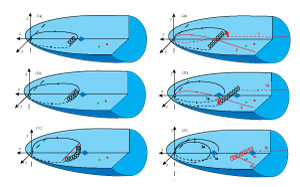2012 ARTEMIS SCIENCE NUGGETS
Formation of tilted flux ropes in the Earth's magnetotail observed with ARTEMIS
by Stefan Kiehas
UCLA IGPP-ESS and
Space Research Institute, Graz, Austria
Introduction
The dual-spacecraft ARTEMIS mission allows, for the first time regular simultaneous observations of transient magnetotail phenomena such as flux ropes and traveling compressed magnetic fields at two different observational points near lunar orbit. Flux ropes are typical features during the course of substorms, transporting mass, energy and magnetic flux towards the Earth and into the magnetotail. They appear as helical magnetic field structures typically with a strong core field and accompanied by fast plasma flows. During their propagation in the tail, flux ropes compress the ambient lobe field, leading to the formation of a region of compressed magnetic fields above and beneath it. These remote signatures of flux ropes are known as travelling compression regions (TCRs).
| Figure 1. Position of the ARTEMIS spacecraft P1 (red) and P2 (green) on 21 October 2010 at 17:00 UT in the (left) x-y-plane and (right) x-z-plane in GSM. The field line configuration is derived from a T89 model. |
Results
On 21 October 2010, ARTEMIS probe P2 observed a series of flux ropes while P1 observed the associated TCRs. These dual-spacecraft observations showed an increase in the propagation speed from one flux rope to the other and indicate impulsive reconnection as the formation process of flux ropes. Initially deep inside the plasma sheet the reconnection rate is slow, but as reconnection proceeds at the plasma boundary and possibly lobes, the reconnection rate increases. An inter-spacecraft time of flight analysis, assuming tailward propagation of cross-tail aligned ropes, suggests propagation speeds of up to 2000 km/s, which is beyond the typical propagation speed of flux ropes and fast plasma flows. A principal axis investigation, however, indicates that the flux ropes were tilted between 41° and 45° in the GSM x-y-plane with respect to the noon-midnight meridional plane.
| Figure 2. Propagation velocity of the five structures observed by P2 and P1 inferred from timing. Blue triangles, red squares and black diamonds indicate the timing results by using signatures in Bx, Bz and P, respectively. The x-axis denotes the time starting at 17:12:30 UT in order to display the relative observation time between the events, based on the inflection in Bz at P2. |
We propose two possible mechanisms for the formation of these tilted flux ropes (Figure 2). In the left panel, reconnection starts near midnight and forms the central segment of the flux rope (step 1a). The reconnection line is indicated by a brown line. As an assumption, the reconnection line spreads along the east-west direction and adds additional twists to the flux rope. Since the central part (formed during step 1a) has moved farther downtail, the newly added twists are trailing the central part (step 1b). As the reconnection line spreads farther along the east-west direction, the flux rope establishes a non-uniform, boomerang-like shape. This also implies that the flux rope is thicker at its center than at its flanks. For simplicity, only one flux rope field line is drawn.
In the second model depicted in the right panel, open field line 1 (located in the southern lobe in the dawn sector) reconnects on the dawnside end of the flux rope (step 2a). Now, this end of the flux rope is no longer connected to the ionosphere and moves into the tail. This leads to a tilting of the flux rope, since the duskside end is still connected to the ionosphere until open field line 2 (located in the northern lobe in the dusk sector) reconnects at this end (step 2b). With no connection to the ionosphere, the flux rope now propagates into the tail (step 2c).
| Figure 3. Two possible scenarios for the formation of tilted flux ropes in the Earth’s magnetosphere (blue). In the initial state of this idealized sketch, the flux rope is resting within the equatorial plane, exhibiting a dawn-dusk extent and is connected at its ends to the Earth’s ionosphere. The two spacecraft P1 and P2 are symbolized by red and green dots, respectively. |
Conclusion
The analysis shows (1) a progressive increase in the propagation velocity from the first to the last flux rope indicating impulsive reconnection as a formation mechanism which starts deep inside the plasma sheet and gradually involves field lines of higher latitudes; (2) that flux ropes can be highly inclined structures. This significantly affects timing analysis since the tilt biases analyses based on the assumption of strictly cross-tail aligned flux ropes. As possible mechanisms leading to the formation of tilted flux ropes we suggest (a) a progressive spreading of the reconnection line along the east-west direction, leading to a boomerang-like shape and (b) a tilting of flux ropes during their formation by non-uniform reconnection with open field lines at the ends of the flux ropes.
Reference
Kiehas, S. A., V. Angelopoulos, A. Runov, M. B. Moldwin, and C. Möstl (2012), On the formation of tilted flux ropes in the Earth's magnetotail observed with ARTEMIS, J. Geophys. Res., 117, A05231, doi:10.1029/2011JA017377.Biographical Note
Stefan Kiehas is a postdoctoral scholar at the University of California in Los Angeles and the Space Research Institute in Graz on an Erwin-Schrödinger fellowship by the Austrian Science Fund (FWF)
 Please send comments/suggestions to
Emmanuel Masongsong / emasongsong@igpp.ucla.edu
Please send comments/suggestions to
Emmanuel Masongsong / emasongsong@igpp.ucla.edu


